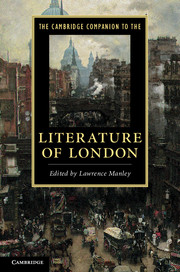Book contents
- Frontmatter
- Introduction
- 1 Images of London in medieval English literature
- 2 London and the early modern stage
- 3 London and the early modern book
- 4 London and poetry to 1750
- 5 Staging London in the Restoration and eighteenth century
- 6 London and narration in the long eighteenth century
- 7 London and nineteenth-century poetry
- 8 London in the Victorian novel
- 9 London in Victorian visual culture
- 10 London in poetry since 1900
- 11 London and modern prose, 1900-1950
- 12 Immigration and postwar London literature
- 13 Writing London in the twenty-first century
- 14 Inner London
- Guide to further reading
- Index
Introduction
Published online by Cambridge University Press: 28 September 2011
- Frontmatter
- Introduction
- 1 Images of London in medieval English literature
- 2 London and the early modern stage
- 3 London and the early modern book
- 4 London and poetry to 1750
- 5 Staging London in the Restoration and eighteenth century
- 6 London and narration in the long eighteenth century
- 7 London and nineteenth-century poetry
- 8 London in the Victorian novel
- 9 London in Victorian visual culture
- 10 London in poetry since 1900
- 11 London and modern prose, 1900-1950
- 12 Immigration and postwar London literature
- 13 Writing London in the twenty-first century
- 14 Inner London
- Guide to further reading
- Index
Summary
Noting that 'the literature of London ... to a large extent ... also represents the literature of England' and that 'English drama and the English novel spring out of the very conditions of London', Peter Ackroyd states a maximal case for the pervasive influence of London on English literature. A correspondingly maximal case for the influence of English literature on the experience of London was offered by John Buchan, author of The Thirty-Nine Steps (1915), when he said that 'every street corner' of London was 'peopled by ghosts from literature and history'. In keeping with these claims for the reciprocal influence of London and literature, it is the premise of this volume that to study the representation of London in English literature is to explore not only variations on a compelling and pervasive topic but a defining element in what has been called the 'topography' or the 'atlas' of English literature. Just as, for reasons explained below and discussed throughout this volume, 'the idea of London is central to the self-image of the British people', and just as the idea of London 'deeply penetrates the rest of the world's view of British life', so, through manifold instances, the imaginative representation of London has helped to shape British literature and, to a significant extent, world literature in English.
- Type
- Chapter
- Information
- The Cambridge Companion to the Literature of London , pp. 1 - 18Publisher: Cambridge University PressPrint publication year: 2011
- 1
- Cited by

